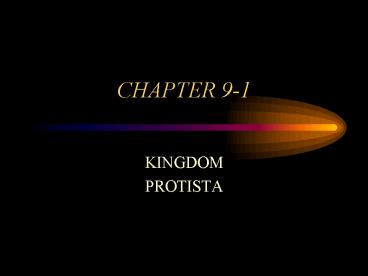KINGDOM PowerPoint PPT Presentation
Title: KINGDOM
1
CHAPTER 9-1
- KINGDOM
- PROTISTA
2
A. WHAT ARE THEY? Page 230
- Single or many celled - may live in colonies
- Live in moist or wet environments
- Eukaryotic
- Great variety
- Plant like (producers)
- Animal like (consumers)
- Fungi like (decomposers)
3
B. Plant like protists
- Algae
- - One or many celled
- Makes own food
- Contains chlorophyll / chloroplasts
- Grouped according to their pigments
4
1. Diatoms phylum Chrysophytachryso golden
brown
Diatom Video
- a) One celled
- b) photosynthetic
- c) stores food in the form of oil
- d) gold-brown pigment masks the green
- e) Their shells collect on the sea floor
- 1) used for road line reflection and
- toothpaste
- f) Made of silica (SiO2) used in glass production
5
2. Dinoflagellates phylum Pyrrophyta
- a) fire algae red pigment
- b) 2 flagella
- - one moves the cell
- - one causes it to spin
- c) food stored as starch and oils
- d) food source for salt water organisms
6
RED TIDE
7
3. Green Algae phylum Chlorophyta
- a) 7,000 species most diverse group
- of protists
- b) green pigment (photosynthesis)
- c) food stored in the form of starch
- d) lives in water, on tree trunks, decks,
- and other organisms
- e) one or many celled
8
Take a look at these cool Green Algae
SPIROGYRAVideo
VOLVOXVideo
Algae used as a bio-fuel source http//gmy.news.ya
hoo.com/v/13190450
9
4. Red Algae phylum Rhodophytarhodo red
- a) used for pudding and toothpaste (gives it
- its smooth texture)
- b) stores food as carbohydrates
- c) most are many celled
- d) Red pigment helpful in absorbing limited
- light in deep ocean depths.
10
(No Transcript)
11
5. Brown Algae phylum Phaeophyta
- a) many celled
- b) Kelp
- c) used in ice cream and marshmallows
- d) produces a carb. Called algin
- e) used to make fertilizer
- f) home (shelter) to many aquatic animals
12
(No Transcript)
13
UNDER SEA FOREST
Kelp Video
14
6. Euglenas phylum Euglenophyta
- a) Have both plant and animal
- characteristics
- b) Contains chloroplasts makes sugar
- c) Get food when light is not present
- d) No cell walls
- e) strong flexible membrane that helps it change
- shape
- f) Use of flagella for movement
- g) Eye spot responds to light..Why?
Euglena Video
15
C. Animal Like Protists
- Called protozoa
- Live in water, soil, and other organisms
- Many are parasites
- Contain digestive vacuoles
- 4 kinds
- Sarcodines 3) Ciliates
- Flagellates 4) Sporozoans
- -Classified by their method of
MOVEMENT
16
1. Sarcodines - phylum Rizopodaex. Amoeba
- a) use of pseudopods for movement and
- feeding
- - false foot
- - extensions of the cytoplasm
- - kind of like endocytosis
- b) found in both salt and fresh water
- c) some found as parasites inside animals
Amoeba Video
17
2. Flagellates phylum - Zoomastigina
- a) move by using flagella
- b) live in fresh water some are parasites
- c) examples
- - Trypanosoma causes African
- sleeping sickness.
- - Some live in termites and produce
- enzymes that allow termites to digest
- wood.
- This relationship is called..
Mutualism
18
3. Ciliates phylum Ciliophora
Paramecium Video
- a) move using cilia
- b) example Paramecium
- - 2 Nuclei Macro (large) cell function
- Micro (small) reproduction
- c) feed on bacteria
- - oral groove
- - Food vacuole digests the food
19
Ciliates continued
- d) Waste products removed through anal
- pore
- e) Contractile vacuole used to remove extra
- water from the cell
- Complex Body Structure
20
4. Sporozoans phylum Sporozoa
- a) all are parasitic
- b) cant move on their own
- c) some feed on the blood of
- humans and other animals
Malaria Video
21
SLIME MOLD
The left photo (courtesy of Prof. I. K. Ross)
shows the plasmodial stage of Stemonitis just
before it formed sporangia. The right photo
(courtesy of Turtox) shows the fully developed
sporangia of Stemonitis.
22
Slime molds are appearing in mulch. To me, they
are beautiful with their intricate structure.
However, most people think they look like
scrambled eggs or dog vomit. They appear in
several sizes and colors with no definite shape.
Those in my mulch change on a daily basis from a
bright yellow netting, to a tan powder, to a dark
brown dried blob.

